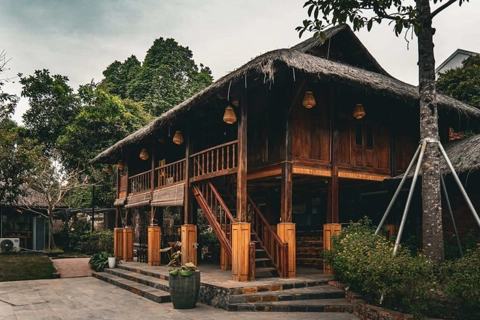Travel
Hanoi develops craft villages in combination with tourism
Feb 25, 2015 / 01:44 PM
Recently, Hanoi’s craft villages have become more and more attractive to both foreign and domestic tourists due to age-old cultural values and creative and specific handicraft products.
With 1,350 craft villages, including 244 traditional villages, Hanoi is the country's largest home for craft villages. The capital’s traditional craft villages such as Bat Trang Ceramic Village, Van Phuc Silk Village, Ha Thai Lacquer Village, Son Dong Wood Carving Village, and Chuyen My Mosaic Village are particularly attractive for international and domestic travelers.
Hanoi’s craft villages lie along main roads and combine with historical and cultural relics and festivals creating opportunities for travel agencies to survey the sites and build tours and new routes to serve tourists. When tourists take craft village tours, they have chances to enjoy countryside landscapes and join the process of creating handicraft products. These are specific attractions to the craft village tours.
For each craft village in Hanoi, tourists will find traditional cultural values hidden in familiar landscapes of the northern delta such as village gates, temples, ancient houses, wells or sophisticated handicraft products which were handed down through generations.
Mai Tien Dung, Deputy Director of the Hanoi Department of Culture, Sports and Tourism said that traditional craft villages were considered as a special tourism resource because their products always include tangible and intangible value. Through the development process, the craft villages have acquired the world’s cultural quintessence and promoted and featured additional cultural traits to handicraft products.
“We are carrying out programmes to assist craft villages to plant tourist signs, define destinations and develop more landscapes. In addition, we will focus on training tourist guides in basic knowledge about craft villages and others to provide more professional services for travelers,” Mr. Dung added.
Meanwhile, Ho Xuan Hung, Deputy Minister of Agriculture and Rural Development stressed that restoring and preserving traditional craft villages, which are facing the high risk of falling into oblivion are crucial. It is necessary to define preservation as the main task and maintain some several craft households or household groups and craftsmen who operate as craft performers to serve tourists’ demand.For discoverers, Hanoi’s traditional craft villages are attractive hotspots. Studying and enjoying cultural traits imbued with regional characters through skillful handicraft and fine art products of craftsmen bring inspiration for tourists to Hanoi.
Hanoi’s craft villages lie along main roads and combine with historical and cultural relics and festivals creating opportunities for travel agencies to survey the sites and build tours and new routes to serve tourists. When tourists take craft village tours, they have chances to enjoy countryside landscapes and join the process of creating handicraft products. These are specific attractions to the craft village tours.
For each craft village in Hanoi, tourists will find traditional cultural values hidden in familiar landscapes of the northern delta such as village gates, temples, ancient houses, wells or sophisticated handicraft products which were handed down through generations.
Mai Tien Dung, Deputy Director of the Hanoi Department of Culture, Sports and Tourism said that traditional craft villages were considered as a special tourism resource because their products always include tangible and intangible value. Through the development process, the craft villages have acquired the world’s cultural quintessence and promoted and featured additional cultural traits to handicraft products.

Foreign tourists studied how to make pottery gifts at Bat Trang ceramic village.
|
Meanwhile, Ho Xuan Hung, Deputy Minister of Agriculture and Rural Development stressed that restoring and preserving traditional craft villages, which are facing the high risk of falling into oblivion are crucial. It is necessary to define preservation as the main task and maintain some several craft households or household groups and craftsmen who operate as craft performers to serve tourists’ demand.For discoverers, Hanoi’s traditional craft villages are attractive hotspots. Studying and enjoying cultural traits imbued with regional characters through skillful handicraft and fine art products of craftsmen bring inspiration for tourists to Hanoi.








